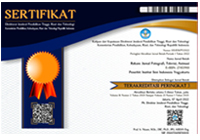Auto Lip-Sync Pada Karakter Virtual 3 Dimensi Menggunakan Blendshape
Abstract
Proses pembuatan karakter virtual 3D yang dapat berbicara seperti manusia merupakan tantangan tersendiri bagi animator. Problematika yang muncul adalah dibutuhkan waktu lama dalam proses pengerjaan serta kompleksitas dari berbagai macam fonem penyusun kalimat. Teknik auto lip-sync digunakan untuk melakukan pembentukan karakter virtual 3D yang dapat berbicara seperti manusia pada umumnya. Preston blair phoneme series dijadikan acuan sebagai pembentukan viseme dalam karakter. Proses pemecahan fonem dan sinkronisasi audio dalam software 3D menjadi tahapan akhir dalam proses pembentukan auto lip-sync dalam karakter virtual 3D.
Â
Auto Lip-Sync on 3D Virtual Character Using Blendshape. Process of making a 3D virtual character who can speak like humans is a challenge for the animators. The problem that arise is that it takes a long time in the process as well as the complexity of the various phonemes making up sentences. Auto lip-sync technique is used to make the formation of a 3D virtual character who can speak like humans in general. Preston Blair phoneme series used as the reference in forming viseme in character. The phonemes solving process and audio synchronization in 3D software becomes the final stage in the process of auto lip-sync in a 3D virtual character.
Keywords
Full Text:
PDFReferences
Arai, K., T. Kurihara, & K. Anjyo. 1996. “Bilinear interpolation for facial expression and metamorphosis in real-time animationâ€. The Visual Computer, Vol. 12, 105–116.
Bergeron, P., & P. Lachapelle. 1985. Controlling facial expression and body movements in the computer generated short â€tony de peltrieâ€.
Cassell, J., S. Prevost, J. Sullivan, & E. Churchill. 2000. Embodied Conversational Agents. Cambridge, MA: MIT Press.
Choe, B., & H. Ko. 2001. “Analysis and synthesis of facial expressions with hand-generated muscle actuation basisâ€. IEEE Computer Animation Conference, (pp. 12-19).
Deng, Z., P. Chiang, P. Fox, & U. Neumann. 2006. “Animating blendshape faces by cross-mapping motion capture dataâ€. Proceedings of the 2006 symposium on Interactive 3D graphics and games, (pp. 43-48).
Fisher, C. 1968. “Confusions among visually perceived consonantsâ€. Journal of Speech and Hearing Research (JSHR), 796–800.
Goldschen, A. J., O.N. Garcia, & E. Petajan. 1994. “Continuous optical automatic speech recognition by lipreadingâ€. In Proceedings of the 28th Asilomar Conference on Signals, Systems, and Computers, (pp. 572–577).
Lewis, J., M. Cordner, & N. Fong. 2000. “Pose space deformationâ€. Proceedings of the 27th annual conference on Computer graphics and interactive techniques (pp. 165-172). SIGGRAPH.
Lewis, J., J. Mooser, Z. Deng, & U. Neumann. 2005. “Reducing blendshape interference by selected motion attenuationâ€. Proceedings of ACM SIGGRAPH Symposium on Interactive 3D Graphics and Games (I3DG), (pp. 25-29).
Martino, J. M., L.P. Magalhaes, & F. Violaro. 2006. “Facial animation based on context-dependent visemesâ€. Journal of Computers and Graphics, Vol. 30, No. 6, 971 – 980.
Parke, F. 1974. “A Parametric Model for Human Facesâ€. Utah: Ph.D. Thesis, University of Utah.
Pighin, F., J. Hecker, D. Lischinski, R. Szeliski, & D. Salesin. 1998. “Synthesizing realistic facial expressions from photographsâ€. SIGGRAPH Proceedings, (pp. 75-84).
Sera, H., S. Morishma, & D. Terzopoulos. 1996. “Physics-based muscle model for mouth shape controlâ€. IEEE International Workshop on Robot and Human Communication, 207-212.
Serenko, A., N. Bontis, & B. Detlor. 2007. “End-user adoption of animated interface agents in everyday work applicationâ€. Behaviour and Information Technology, 119-123.
Sifakis, E., I. Neverov, & R. Fedkiw. 2005. “Automatic determination of facial muscle activations from sparse motion capture marker dataâ€. ACM Trans. Graph 24(3), (pp. 417–425).
Taylor, S., M. Mahler, B. Theobald, & I. Matthews. 2012. “Dynamic units of visual speechâ€. In ACM/ Eurographics Symposium on Computer Animation (SCA), 275–284.
Walden, B. E., R.A. Prosek, A.A. Montgomery, C.K. Scherr, & C. J. Jones. 1977. “Effects of training on the visual recognition of consonantsâ€. Journal of Speech, Language and Hearing Research (JSLHR), Vol. 20, No. 1, 130–145.
Waters, K., & T. Levergood, T. 1993. Decface: An automatic lip-synchronization.
DOI: https://doi.org/10.24821/rekam.v11i2.1299
Article Metrics
Abstract view : 0 timesPDF - 0 times
Refbacks
- There are currently no refbacks.

This work is licensed under a Creative Commons Attribution 4.0 International License.Â



